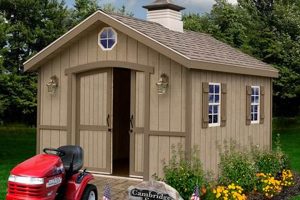The construction and installation of storage solutions within a residential garage setting, utilizing lumber and intended to be assembled by the homeowner, represents a common practice for maximizing space. This involves the selection of wood materials, cutting and shaping them to specified dimensions, and assembling the resulting components into shelving units designed to hold various items.
Such projects offer several advantages, including customizable dimensions to fit specific spatial constraints, cost savings compared to professionally installed systems, and the satisfaction of a completed home improvement task. Historically, the desire to efficiently organize tools, equipment, and household overflow has driven the adoption of these self-made storage solutions, evolving from simple stacked planks to more sophisticated, engineered designs.
The following discussion will elaborate on crucial aspects of planning, material selection, construction techniques, and safety considerations relevant to successfully executing a durable and functional storage system within the garage environment.
Essential Guidance for Garage Storage Construction
The subsequent points outline key considerations for ensuring a successful and enduring garage storage implementation. Attention to these details will contribute to both the functionality and structural integrity of the finished product.
Tip 1: Structural Load Assessment: Prior to design implementation, evaluate the maximum weight each shelf must bear. This dictates the required lumber dimensions, bracing, and attachment methods to wall studs or ceiling joists.
Tip 2: Lumber Selection: Opt for kiln-dried lumber to minimize warping and shrinking post-construction. Consider species like pine, fir, or pressure-treated wood for increased durability and resistance to moisture. Avoid knotty or visibly damaged wood.
Tip 3: Precise Measurements: Accurate measurements are crucial. Account for all dimensions, including wall irregularities and obstructions (e.g., pipes, electrical boxes). Double-check all cuts before assembly.
Tip 4: Secure Fasteners: Employ appropriate screws or lag bolts specifically designed for wood construction. Pre-drilling pilot holes minimizes wood splitting and enhances holding power. Avoid using nails for structural connections.
Tip 5: Level Installation: Use a level throughout the installation process to ensure shelves are perfectly horizontal. Slight deviations can lead to instability and uneven weight distribution.
Tip 6: Adequate Bracing: Incorporate diagonal bracing, particularly for deeper shelves, to prevent racking and increase stability. Attach bracing securely to both the shelves and the wall studs or framing members.
Tip 7: Consider Adjustable Shelving: Employ shelving standards and brackets to allow for future adjustments in shelf height, accommodating diverse storage needs over time. This adds flexibility and long-term utility to the system.
These guidelines underscore the importance of meticulous planning, appropriate material selection, and precise execution in the construction of dependable garage storage solutions. Adherence to these principles will result in a robust and functional storage system.
The forthcoming section will focus on safety protocols and best practices to ensure a secure construction process and a safe end-product.
1. Planning Dimensions
The initial phase of constructing shelving mandates meticulous dimension planning. This directly influences the utility, structural integrity, and overall aesthetic appeal. Inadequate dimensional assessments can lead to wasted materials, unstable structures, or a system that fails to accommodate intended storage needs. A homeowner’s garage with limited height would necessitate shallower shelf depths than a garage with ample vertical space. Overlooking this distinction during dimension planning could result in reduced storage capacity and an inefficient use of the available space.
Practical implementation requires a thorough inventory of items to be stored, along with precise measurements of the available area. This data informs decisions regarding shelf depth, width, height, and spacing. An example is a shelving unit designed to store heavy toolboxes; the depth must accommodate the largest toolbox, while shelf spacing must allow for vertical clearance. Failure to accurately plan shelf depth can result in overhangs and limited access.
Accurate planning of the dimensions is critical. The consequence of neglecting this step ranges from minor inconveniences to significant structural issues. Proper dimensioning is essential for achieving a functional and safe storage system, effectively utilizing available space, and ensuring the longevity of the constructed shelving.
2. Material Selection
The selection of appropriate materials constitutes a foundational decision in the construction of shelving. The type and grade of wood directly impact the structural integrity, longevity, and overall suitability for a garage environment. Thoughtful material selection minimizes potential issues related to weight capacity, environmental factors, and long-term maintenance.
- Wood Species and Strength
Different wood species offer varying degrees of strength and resistance to warping. Softwoods like pine are cost-effective but may be less durable under heavy loads. Hardwoods such as oak offer superior strength but at a higher price point. Engineered wood products like plywood provide stability and resistance to splitting. Selecting a species appropriate for the intended load and environmental conditions is essential. For example, shelves intended for storing heavy tools require hardwoods or reinforced plywood to prevent sagging.
- Moisture Resistance
Garage environments are often subject to humidity fluctuations and potential water exposure. Untreated lumber is susceptible to rot and decay. Pressure-treated lumber offers enhanced resistance to moisture but may contain chemicals that necessitate caution during handling. Applying a sealant or paint coating can provide a barrier against moisture penetration, extending the lifespan of the wood. Failure to address moisture concerns can result in structural degradation and eventual failure of the shelving unit.
- Dimensional Stability
Wood expands and contracts with changes in humidity. Kiln-dried lumber is less prone to warping and shrinking compared to green lumber. Selecting lumber with low moisture content minimizes dimensional changes, preserving the structural integrity and appearance of the shelving over time. Improperly dried lumber can lead to gaps, uneven surfaces, and weakened joints as it acclimatizes to the garage environment.
- Cost-Effectiveness and Availability
The chosen material should align with budget constraints and ease of procurement. While hardwoods offer superior performance, softwoods or engineered wood products may provide an acceptable balance between cost and durability. Local availability also plays a crucial role in material selection. Transportation costs for specialized lumber can significantly impact the overall project expense. Balancing performance requirements with budgetary realities and logistical considerations is essential for a successful shelving project.
The facets of material selection illustrate its significance in garage storage design and creation. Prioritizing durable, dimensionally stable, and moisture-resistant materials enables a long-lasting and functional storage system. Careful consideration of these factors maximizes the investment in a project while ensuring a safe and organized workspace.
3. Structural Support
Structural support is a critical element in the construction of shelving. It determines the load-bearing capacity, stability, and overall longevity of the system. Insufficient structural support can lead to shelf sagging, collapse, and potential injury or damage to stored items. Understanding the principles of structural support is therefore paramount to a shelving project.
- Vertical Supports (Uprights)
Vertical supports bear the entire weight of the shelving unit and its contents. These are typically constructed from wood, with dimensions dependent on the intended load. The spacing of vertical supports influences load distribution; closer spacing enhances weight-bearing capacity. An example is the use of 2×4 lumber for uprights spaced 24 inches apart to support moderate loads, while heavier loads necessitate thicker lumber and closer spacing. Improperly sized or spaced vertical supports compromise the entire structure.
- Horizontal Supports (Shelf Framing)
Horizontal supports provide the framework for the shelves themselves, distributing the load across the vertical supports. These can be constructed using dimensional lumber or metal brackets. The span (distance between vertical supports) and depth of the shelf dictate the required strength of the horizontal supports. A shelf spanning 48 inches requires more robust horizontal support than a shelf spanning 24 inches. Inadequate horizontal support results in shelf sagging, particularly under heavy loads.
- Bracing (Diagonal and Rear)
Bracing enhances the stability and rigidity of the shelving unit, preventing racking (sideways movement) and collapse. Diagonal bracing connects the vertical and horizontal supports, distributing forces and preventing deformation. Rear bracing, often consisting of a solid sheet of plywood or OSB, provides additional lateral stability. Bracing is especially important for tall or narrow shelving units that are more susceptible to tipping. An absence of bracing increases the risk of structural failure.
- Anchoring to Walls
Anchoring the shelving unit to the wall studs provides additional stability and prevents tipping, particularly important for heavy or tall units. This is typically achieved using screws or lag bolts driven through the shelving frame into the wall studs. The frequency and type of anchors depend on the weight of the shelving unit and its contents. Neglecting to anchor the unit can pose a safety hazard, especially in areas prone to seismic activity or accidental impacts.
These components, acting in concert, ensure the structural integrity. The selection of materials, dimensions, and construction techniques all contribute to the overall effectiveness of the support system. Proper attention to these aspects is crucial for the safe and reliable functioning of shelving.
4. Fastening Methods
The durability and structural integrity of garage wood shelves are fundamentally determined by the employed fastening methods. The manner in which lumber components are joined directly affects the system’s ability to withstand sustained loads, resist warping, and maintain stability over time. Inadequate fastening techniques are a primary cause of premature failure in shelving. For example, using improperly sized nails to join shelf supports can result in the nails pulling out under stress, leading to shelf sagging or complete collapse. The selection of appropriate fasteners, coupled with proper installation techniques, is therefore crucial.
Several fastening methods are commonly used in constructing garage wood shelves, each offering distinct advantages and disadvantages. Screws, specifically wood screws or construction screws, provide superior holding power compared to nails due to their threaded design. This makes them well-suited for joining critical structural elements. Bolts, used in conjunction with nuts and washers, offer even greater strength, particularly when joining thicker lumber or attaching shelves to wall studs. Wood glue, when used in conjunction with mechanical fasteners, creates a bond that significantly increases joint strength. Dowels, cylindrical wooden pins inserted into pre-drilled holes, provide alignment and reinforcement for joints. The specific method chosen depends on factors such as the type of wood used, the expected load, and the desired aesthetic. An illustration of this is the use of lag bolts to secure the shelving uprights to wall studs, providing a robust connection that can withstand substantial weight and prevent tipping.
In summary, the significance of proper fastening methods in DIY garage wood shelves cannot be overstated. These methods dictate the reliability and longevity of the storage system. Careful selection of fasteners, combined with the precise execution of joining techniques, is essential for creating a safe and functional storage solution. Challenges such as selecting the correct screw length or ensuring proper alignment must be addressed to achieve optimal results, reinforcing the integral link between fastening and the overall success of the project.
5. Shelf Spacing
Shelf spacing, the vertical distance between shelves, is a fundamental determinant of the storage capacity and utility of shelving. In the context of self-constructed garage shelving, this parameter directly influences the range of items that can be accommodated, the efficiency of space utilization, and the accessibility of stored goods. Inadequate spacing can lead to wasted vertical volume, while excessive spacing reduces the total number of storage tiers. The selection of shelf spacing, therefore, represents a crucial design decision with cascading effects on the functionality of the system.
The optimal shelf spacing is contingent upon the specific storage needs of the user. For instance, a workshop that primarily stores small hand tools and hardware containers will benefit from closely spaced shelves, maximizing the number of accessible storage levels. Conversely, a garage used to store large items such as seasonal decorations or automotive parts necessitates wider spacing to accommodate the vertical dimensions of these objects. A failure to anticipate these storage needs during the design phase can result in a system that is either underutilized or incapable of effectively storing intended items. As a consequence, the importance of assessing storage requirements cannot be overstated.
Effective planning of shelf spacing maximizes storage efficiency and convenience. It demands foresight into storage requirements, with consideration to the future needs. Careful attention to this aspect significantly enhances the utility and practicality of self-assembled garage shelving units, supporting and improving the efficient organization of the workspace or storage environment.
6. Load Capacity
Load capacity is a paramount consideration in the design and construction of garage wood shelves. It dictates the maximum weight a shelf can safely bear without structural failure. An underestimation of load requirements or a disregard for material limitations can result in compromised structural integrity, potentially leading to property damage or personal injury. Effective load capacity planning is, therefore, essential for the safe and reliable operation of the storage system.
- Material Selection and Load Bearing
The type of wood used directly influences the load-bearing capacity of the shelves. Softer woods, such as pine, exhibit lower strength compared to hardwoods like oak or maple. Engineered wood products, like plywood, offer consistent strength properties but must be selected with appropriate thickness and grade for the intended load. For example, shelving designed to store heavy automotive parts necessitates the use of hardwoods or reinforced plywood to prevent sagging or collapse. A failure to match the material strength to the load requirements poses a significant risk to the structure.
- Span Distance and Deflection
The span distance, or the distance between vertical supports, significantly impacts the deflection (bending) of a shelf under load. Longer spans exhibit greater deflection for a given load and material. Excessive deflection can lead to instability and eventual failure. In practice, shelves with longer spans require thicker lumber or the addition of mid-span supports to minimize deflection. Miscalculating the maximum permissible span for a given load and material can lead to catastrophic results.
- Joint Strength and Fasteners
The strength of the joints connecting the shelf components is critical to the overall load capacity. Properly selected and installed fasteners, such as screws or bolts, distribute the load across the joints. The use of inappropriate fasteners or inadequate joint construction techniques can result in joint failure, even if the lumber itself is sufficiently strong. For instance, shelves secured with only nails may not withstand sustained heavy loads, leading to eventual joint separation.
- Weight Distribution and Shelf Arrangement
The manner in which weight is distributed on the shelves affects the overall load capacity. Concentrated loads, where the majority of the weight is focused in a small area, create greater stress than evenly distributed loads. Strategic shelf arrangement, with heavier items placed closer to vertical supports and lighter items distributed more evenly, maximizes the load-bearing capacity. Neglecting proper weight distribution can overload specific sections of the shelving unit, increasing the risk of failure.
These considerations are instrumental to creating strong garage storage. Recognizing the interrelationship of these components to maximize strength prevents failure and protects stored materials.
7. Safety Considerations
The intersection of safety considerations and self-constructed shelving within a garage environment necessitates a structured approach to risk mitigation. Shelving, inherently intended to support substantial weight, presents a direct safety hazard if inadequately designed, constructed, or utilized. Real-world instances of shelving collapse due to overloading, improper fastening, or unstable materials underscore the critical importance of integrating safety protocols throughout the entire DIY process. Neglecting these considerations can precipitate a range of adverse outcomes, from damage to stored property to serious physical injury.
Effective safety implementation extends beyond adherence to basic construction principles. The proper selection of Personal Protective Equipment (PPE), such as safety glasses and gloves, is crucial during the construction phase to prevent injuries from splinters, sharp edges, or falling debris. Furthermore, a thorough assessment of the intended load capacity is essential to prevent overloading, which is a frequent cause of shelving failure. The structural integrity of the supporting walls or ceiling joists must also be verified to ensure they can withstand the weight of the loaded shelving unit. An example of this is identifying and avoiding electrical wiring or plumbing within the wall before anchoring shelving, preventing potential electrocution or water damage.
In summary, safety constitutes an indispensable component of successful self-constructed garage shelving. By integrating safety practices into planning, construction, and utilization, individuals can significantly reduce the risk of accidents and create a secure and functional storage system. However, challenges such as overconfidence, inadequate planning, and rushing through the construction process can undermine safety efforts, underscoring the need for consistent diligence and a commitment to best practices throughout the project lifecycle.
Frequently Asked Questions
The following addresses common inquiries regarding the design, construction, and maintenance of shelving within a garage setting. This information is intended to clarify essential considerations for a safe and effective project.
Question 1: What is the minimum recommended lumber thickness for garage shelving designed to support heavy items?
Lumber thickness is contingent upon the intended load and shelf span. As a general guideline, shelving designed to support substantial weight (e.g., automotive parts, heavy tools) should utilize lumber with a minimum thickness of 1-inch (nominal dimension), such as 1×12 or 2×12 lumber. Shorter spans require less robust material, while longer spans necessitate greater thickness or intermediate support.
Question 2: How can one ensure proper anchoring of garage shelving to wall studs?
Effective anchoring necessitates locating wall studs using a stud finder or other appropriate method. Screws or lag bolts should be driven through the shelving frame and directly into the center of the studs. The length of the fastener should be sufficient to penetrate at least 1.5 inches into the stud. The spacing between anchors should be determined based on the weight of the shelving unit and its contents, but a minimum of two anchors per vertical support is recommended.
Question 3: What safety precautions should be observed during the construction and installation process?
Safety glasses should be worn at all times to protect against flying debris. Gloves are recommended to prevent splinters and abrasions. Power tools should be operated in accordance with manufacturer instructions, and appropriate hearing protection should be used when necessary. A dust mask or respirator is advisable when cutting or sanding wood to minimize inhalation of particulate matter. A stable work platform or ladder should be used to access elevated areas.
Question 4: How can one prevent shelf sagging under heavy loads?
Shelf sagging can be minimized by selecting lumber with sufficient thickness and strength, reducing the span distance between vertical supports, and incorporating mid-span supports. Reinforcing the shelf with a metal stiffener or bracing can also increase its load-bearing capacity. Proper weight distribution is also crucial, with heavier items placed closer to the supports and lighter items distributed more evenly.
Question 5: What type of finish is recommended for garage shelving to protect against moisture and wear?
A durable finish is essential to protect the wood from moisture, scratches, and stains. Options include exterior-grade paint, polyurethane varnish, or epoxy coatings. Multiple coats are recommended for optimal protection. The finish should be applied according to the manufacturer’s instructions, and adequate drying time should be allowed between coats.
Question 6: How frequently should garage shelving be inspected for signs of damage or wear?
Regular inspections are essential to identify potential problems before they escalate. Shelving should be inspected at least twice per year for signs of sagging, warping, loose fasteners, or damage to the wood or finish. Any deficiencies should be addressed promptly to maintain the structural integrity and safety of the system. Replace any components if they show significant wear.
These inquiries represent key considerations in DIY Garage Wood Shelves. Diligent adherence to these insights improves the structural integrity.
The subsequent section will transition to preventative maintenance.
DIY Garage Wood Shelves
This exploration of the principles involved in building storage systems underscores the critical importance of meticulous planning, appropriate material selection, and precise execution. From understanding load-bearing capacities to implementing effective fastening methods, each aspect contributes directly to the safety, durability, and overall utility of the finished product. Attention to detail throughout the project is paramount.
The diligent application of these insights will translate into a functional storage system. Prioritizing structural integrity and safe practices ensures the long-term viability of the investment and contributes to a more organized and secure garage environment.







